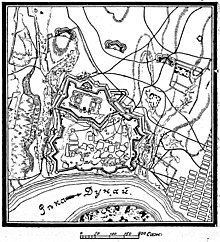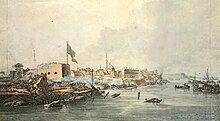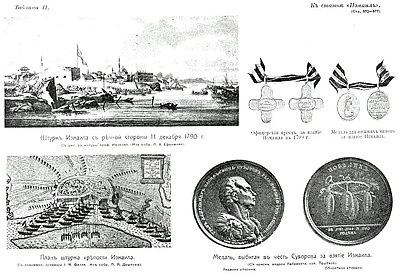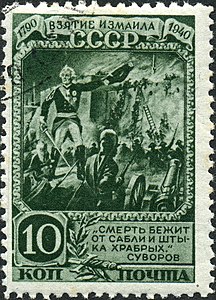Siege of Izmail
| Storming of Izmail | |||||||
|---|---|---|---|---|---|---|---|
| Part ofRusso-Turkish War (1787–1792) | |||||||
 The capture of Izmail by Russian troops under the command ofGeneral-in-ChiefA. V. Suvorov on 11 December 1791,Mikhail Ivanov | |||||||
| |||||||
| Belligerents | |||||||
| Commanders and leaders | |||||||
|
|
| ||||||
| Units involved | |||||||
|
| |||||||
| Strength | |||||||
|
28,000–32,000[g] 500[7]to 600[1]guns |
40,000–42,000[h] 265 guns[10][7] | ||||||
| Casualties and losses | |||||||
| 4,582 to 10,000 killed & wounded[i] |
Total: 40,000 casualties[8] all artillery pieces[8][10]up to 400standards[10] | ||||||


Thesiege of IzmailorIsmail/Ishmael/İzmail(Turkish:İzmail Kuşatması), also called thestorming of Izmail[8](Russian:Штурм Измаила), was amilitary actionfought in 1790 on theBlack Seaduring theRusso-Turkish War (1787–1792)and simultaneously theAustro-Turkish War (1788–91).The Russians were led byAlexander Suvorov,who had defeated theOttomansatKinburn,Focsani,andRymnik,as well as participating in thesiege of Ochakov.The Black Sea rowingflotillawas commanded by the Spanish admiralJosé de Ribas(Iosif Deribas). It is regarded as one of Suvorov's finest victories and one of the greatest deeds in world military history.[16]
The fortress was considered to be impregnable and was referred to as "a fortress without weak points",[17]and was commanded by one of the best and most experienced Ottoman generals,Aydoslu Mehmed Pasha.[18][19]
Background
[edit]Suvorovgave Commander-in-ChiefPotemkinadvice regarding subsequent military operations; "rowing fleet should seize theDanube Delta,takeTulchaandIsaktcha,together with ground troops to conquerIzmailandBrailovand put a tremor onSistovo".Two detachments were intended for action on theLower Danube;with the help of a rowing fleet they were to take possession of all local Turkish fortifications, destroy Ottoman river vessels and generally clear the Lower Danube with its coasts. Most of this task was accomplished without special effort; by the end of November, the small fortresses ofKilia,[k]Tulcea, and Isaktcha were in Russian hands, and the Ottoman rowing flotillas had been annihilated. There remained the formidablestrongholdof Izmail,[20]"the key to theDanube",[13]built under the direction ofGermanandFrenchengineers, in the region ofBudjak(now in Ukraine).[1][6]
The siege of Izmail in December 1790 was undertaken due to order of thesupreme commanderof the Russian Southern Army,General-FeldmarshalGrigory Potyomkin,– commonly known as Potemkin, – appointing a new leader of the Izmailian forces. NeitherNikolay Repnin(1789), norIvan Gudovich,replaced bySamoylov,norPavel Potyomkin(November, 1790) were able to meet the challenge, failing thesiegeeither through lack of overall command, or the sluggishness, or the indecisiveness on the part of their troops or themselves; after which Grigory Potyomkin assigned the task of supervising the troops assembled at Izmail to General-in-Chief Count Suvorov-Rymniksky, who was then watchingGalatzand Brailov with his corps.[1]The news of Suvorov's appointment spread throughout the flotilla and the siege corps instantly. Every soldier understood what the denouement of the inaction would be, and one of the top officials in his private letter expressed himself: "as soon as Suvorov arrives, the fortress will be stormed".[21]
Austrian actions
[edit]More recently in 1790,Coburg'sAustrianstookOrșova.Afterwards, they tried tobesiege Giurgiustronghold: at first things went well for the Austrians there, but the Ottomans, in Prince of Coburg's absence, made a very successful sortie that spoilt the whole affair. They drove the Austrians away, took their artillery, and inflicted a loss of 1,000 men. The Austrians were 6 times stronger than thegarrisonof Giurgiu, but despite this, they lost all theirsiege artilleryand were forced to retreat from Giurgiu. Potemkin gloatingly described this affair tohis sovereign,mentioning Coburg in every negative way, but Coburg had no part in this rout.[22][23]The affair at Giurgiu was a mere private failure, which, at the end of the same month of June,General Clerfaytpartly made up for by a victory over the Turks atCalafat.But with these three deeds of the Austrians their active operations ended.[23]
Preparations
[edit]Trainings
[edit]Arriving at Izmail on 13 December, Suvorov immediately began preparations for an assault. His troops were positioned in a semicircle 2.1 kilometres (1.3 mi) from the fortress; their flanks rested on the river, where Deribas' flotilla and the detachment on Çatal Island (5 battalions of infantry with 8 artillery batteries) started theblockade.Reconnaissance was underway for several days in a row, with the participation of both Suvorov himself and his superiors; ladders andfascineswere being prepared at the same time; Suvorov went among the soldiers, egging them on, joking with them. He would point towards Izmail and say, "There is the fortress. Its walls are high, its ditches deep, but we must take it. Our Mother,the Empress,has ordered it, and we must obey her ". In order to inspire the Turks with the idea that the Russian meant to conduct a proper siege, on the night of 18 December, on both flanks were laid batteries, each with 10 guns: two — on the west side, 300 m. from the fortification, and two — on the east side, not more than 370 m. from the hedge. To train troops for make an assault, a moat was dug in the distance and pouredrampartslike Izmail; secretly on the night of 19 and 20 December Suvorov personally showed the troopsescaladetechniques and taught them to act with a bayonet, with the fascines represented by the Turks.[1][13][7]On 18 December, 2 o'clock in the afternoon, Suvorov sent a note to thecommandantof Izmail:[1]
ToSerasker,elders and all your society: I arrived here with the troops. Twenty-four hours to think about surrender and twenty-four hours of liberty; my first shots mean that liberty is gone; the assault is death. This is what I leave you for consideration.
The next day came a reply from serasker, who asked permission to send two men to theGrand Vizierfor a command and offered to conclude an armistice for 10 days. By 20 December Suvorov replied that he could not agree to the serasker's request and gave a deadline until the morning of the 21st day. In the appointed time there was no reply and the fate of Izmail was decided.[1]
Short bombardment
[edit]The Russians had only 40field guns,but no siege guns at all. Field artillery had no more than one set of ammunition; there was an extreme shortage of food, which could not be replenished due to winter conditions and lack of time; there were many sick soldiers. On the whole the state of Russian affairs there seemed very disappointing; nevertheless the assault was militarily and politically necessary.[5]Alexander Suvorov's aim was to squeeze the fortress with pincers from three sides. The Ottomans would greatly disperse their forces and would not be able to support each other in the event of a possible breakthrough of any of the sections. This applied not only to the Ottoman soldiers, but also to their guns, many of which would also go to defend against Deribas' flotilla, rather than against Suvorov's own assault columns.
One day before the assault (21 December), Suvorov ordered thebombardof Izmail (withnavaland ground cannons).[7]The only unprotected section of this fortress was on the Danube side,[7]which was supposed to be defended by ships. Yet the Ottoman fleet had already been defeated by the Russian one during theBattle of Tendraby the great Russia's admiral of those times —Fyodor Ushakov.[24]
An artillery duel took place. At sunrise the assault preparation was begun by fire from the flank batteries, Çatal, and flotilla ships; cannons were smashing Izmail until late at night; the Turkish artillery answered, but soon the firing from the fortress became weaker and finally stopped. Thanks to the fleet, the Russians had an advantage in guns.[1]The firefight started unsuccessfully for the Russians, when a lucky Ottomancannonballhit thepowderchamber of thefrigateKonstantin,after which it blew up, but this did not help the Ottomans win the duel either. The bombardment continued until 3:00 am, but since there were no siege guns on land, the walls could not be breached.[citation needed]
The assault and its planning
[edit]Disposition
[edit]Numbers
[edit]On the early dusky morning of 22 December 1790, the Russians hoped to take their enemy by surprise,[7]however, information about Suvorov's plans of assault was leaked to the Turkish camp.[citation needed]The Russians began the assault on Izmail, which had agarrisonof 35,000 soldiers[10](or 40,000[6]), of which around 15,000regulartroops and ~20,000militias,[12]under the leadership ofAydoslu Mehmed Pasha,a firm, resolute, and battle-tested commander.[1]Suvorov had 31,000 troops, of which 15,000 wereirregularand poorly armed.[10]

Plan of attack
[edit]Suvorov's troops consisted of: the right wing, commanded byPavel Potyomkin,formed out of thecolumnsof Lvov, Lacy, and Meknob; the left wing, commanded byAlexander Samoylov,formed out of the columns of Orlov,Platov,andGolenishchev-Kutuzov(Kutuzov); the fleet —Iosif Deribas— his landing columns under the command ofArsenyev,Chepiha,and Markov.[7]The detachment of Deribas (9,000) was to attack from the river side, with the right column ofMajor GeneralArsenyev (3 battalions and 2,000Cossacks) was given the task to attack the New Fortress, the middle column ofBrigadierChepiha (3 battalions and 1,000 Cossacks) — the center of the coastal front, the left column of Major General Markov (5 battalions and 1,000 Cossacks) — the Old Fortress. The flotilla was ordered to approach Izmail, being built in two lines: the 1st — 145 light ships and Cossack boats with landing troops, the 2nd — 58 large ships, which by fire of heavy guns were to cover the landing. The detachment ofLieutenant GeneralPotyomkin (7,500) was to lead the assault against the fortress' western side with the right column of Major General Lvov to seize the redoubt of Tabia and then spread to the left; the middle column of Major General Lacy to seize thecurtain wallat the Bros gate and spread to the left all the way to the Khota gate; the left column of Major General Meknob was to seize the curtain wall at the Khota gate and spread to the left. Each column consisted of 5 battalions; 150jaegerswere to go at the head, followed by 50 workers with tools, then 3 battalions with fascines and ladders, and a reserve of 2 battalions at the tail. The detachment of Lieutenant General Samoylov (12,000) was to go against the eastern front, with the leading column of Brigadier Orlov (2,000 Cossacks) was to seize the rampart east of the Bender gate and spread to the left to support the middle column of Brigadier Platov (5,000 Cossacks), which was to climb the rampart through the valley that divided the Old and New Fortress, and then contribute to the Deribas troops; 150 selected Cossacks with rifles were to march in front of each column, followed by 50 workers, and then the remaining Cossacks on foot; two battalions of infantry were to serve as a reserve for both columns, given under the command of Major General Bezborodko; left column of Major General Golenishchev-Kutuzov (5 battalions and 1,000 Cossacks) was to seize the rampart at Cilic gate, then spread to the right and left. Westphalen's cavalry (2,500) was assigned to the reserve; 10squadronswere divided into 3 detachments, which stood against the Bros, Khota and Bender gates; 4 Cossack regiments were positioned further to the east and 1 squadron was left atwagon fort.[1]

Storming
[edit]To the walls
[edit]At 3 a.m. on the 22th the 1st signal flare went up, by which the troops moved to the positions; at 5:30 a.m. by the 3rd flare the troops moved to the assault. Turks opened fire with cannons. Lacy's column was the first to climb the rampart. Lvov's column failed to take Tabia redoubt, despite the heroism ofSuvorov's Phanagorian grenadiersand Apsheron riflemen, who "fought like lions", repelling a raid, and took possession of the first batteries, but no more;[25]Lacy was wounded andColonelZolotukhin took command, managing to take Bros and Khota gates and join Lacy's column. Meknob's column had the hardest time, attacking the largebastionin the northwestern corner of the fortress, the one next to it to the east, and the curtain wall between them (instead of the curtain wall assigned to it by the disposition); here the rampart had a small height, and the serasker himself defended this section with eliteJanissaries;but, despite the enormous losses, the troops of the column, under Colonel Khvostov, who replaced the wounded Meknob, brilliantly accomplished the task. The Turks made a desperate sortie from the Bender gate against Brigadier Orlov's column, as it began to climb the rampart, Thanks to the timely arrival of Suvorov's reinforcements (1 battalion of infantry, 7 squadrons and 1 regiment of Cossacks), the sortie was repulsed, but Orlov managed to capture the wall only with the help of Platov's troops. Platov, advancing along the ravine, met an obstacle — a curtain wall, which, crossing the stream flowing through the ravine, formed a dam, waist-deep; Cossacks crossed in the ford and, with the help of infantry battalion sent to their aid, seized the curtain wall; after that part of Platov's troops moved to support Orlov's column, while another part got in contact with Arsenyev's column. Golenishchev-Kutuzov's column after a fierce battle seized the Cilic gate. Deribas' detachment about 7 am, despite the resistance of 10,000 Turks andCrimean Tatars,successfully made the landing and seized the points assigned to him by disposition.[1][13]
Inside the stronghold
[edit]By 8 a.m. the Russian troops firmly established themselves on the ramparts of Izmail; the Bros, Khota, and Bender gates were opened, and the cavalry reserves entered the fortress.[1][6]The first to step on the fortress walls wasMajorNekludov;[10]and after a short rest, the assault columns from different sides moved toward the center of the city. A new fierce fighting began; the Turks resisted stubbornly; every building, every scrap of land in the fortress had to be taken with the fight.[1]The Russians made their way into the Old and the New Fortresses, as well as theCitadel.[13][7]Garrisoned Crimean Tatars and some Turks, commanded by Qaplan Geray (cousin of thelastCrimeanKhanand victor against the Austrians at Giurgiu in 1789[26]), then made a desperate attempt to recapture Izmail with 3,000-4,000 men in the Old Fortress. They overturned theBlack Sea Cossacks,taking away two of their guns, but the regular infantry stopped this onslaught.[27]Five of Qaplan's sons were killed with Qaplan Geray himself, and including Maqsud Geray, descendant ofGenghis Khanhimself.[27][26]By about 4 o'clock in the afternoon the battle subsided; Izmail was taken by the Russians.[1][13]

C. Schulz del. et Sculp. 1790
Result
[edit]Many ships, munitions and various riches (gold,silver,pearlsandprecious stones) went to the victors. Several thousand women, children,Jews,ArmeniansandMoldavianssettled in the city. Of the entire garrison only one man escaped.[28]In total, the Ottoman forces had more than 26,000 casualties with the almost whole armed force of the stronghold being killed.[6]Those who were wounded were captured.[citation needed]The siege hardships and the stubborn Ottoman resistance irritated their victor to the last degree: they gave no mercy to anyone; everyone died under the blows of the furious soldiers, — both the stubbornly defensive and the weaponless, even women and children.[29][30]Even the officers could not keep people from aimless bloodshed and blind rage.[30]According to the promise given in advance by Suvorov, the city was given to the soldiers for 3 days, — this was the custom of that time; therefore, on the next and on the third day, more cases of violence and murder continued, and on the first night, the crackle of rifle and pistol shots rang out until the morning. The robbery took on terrible proportions. Soldiers broke into houses and seized all kinds of property, — rich clothes, precious weapons, jewelry; merchants' shops were smashed, and over their owners' corpses the new masters sought the spoils; many houses stood dilapidated, their inhabitants lay in blood, screams for help, cries of despair, the wheezing of the dying were heard everywhere; the conquered city presented a terrifying sight.[31]Russian forces suffered only 4,330 casualties, out of which 1,815 were killed.[6]The participants of the Ochakov storming considered it a "toy" compared to the Izmail assault, and Suvorov himself later said that
"such an extraordinary storm could be dared only once in a lifetime."[32]
Immediately after the complete conquest of the fortress, Suvorov ordered measures to ensure order. Mikhail Golenishchev-Kutuzov was appointed commandant of the fortress for his courage in battle, guards were placed in the most important places, patrols were sent in different directions of the city.[33][27][7]AndCatherine IIawarded Suvorov the rank oflieutenant colonelof thePreobrazhensky Life Guards Regiment,where she herself was acolonel.[34]The dead were being cleaned up, and help was being given to the wounded. A huge hospital was opened inside the city because the number of wounded was huge. The bodies of the murdered Russians were taken out of this city and buried according to the church rite. There were so many Turkish corpses that there was no way to bury all the dead, and yet their decomposition could lead to the spread of infection; therefore, it was ordered to throw the bodies into the Danube and prisoners were used for this work, divided into turns. But even with this method, it was only after 6 days that Izmail was cleared of corpses.[33]
The conquest of Izmail was of great political importance, as it influenced the further course of the war andthe conclusion of peacein 1791.[35]
The impression made by the storming of Izmail onTurkeyandEuropewas numbing. TheSistovaconferences were interrupted (representatives of the European powers negotiated with theOttoman Empire[36]); the Turks began to flee fromMaçinandBabadag;inBucharestthey simply did not believe what had happened, and in Brailov, despite the 12-thousand garrison, "the inhabitants asked thepashato surrender when the Russian (troops) approached the fortress, so that they would not suffer the same fate as Izmail ". InConstantinoplethe Ottomans remembered the legend that a blond people would come from the north and drive them intoAsia.Therefore, fear and despondency prevailed in the Turkish capital, every minute expected outrage; it was strictly forbidden to talk about the actions of the Russians; when the rumor of the capture of Izmail did spread, the excitement of the people reached extreme proportions. The Ottomans spoke of the necessity of strengthening the capital, of ageneral militia,but the summoning of troops was not successful.[35]
The storming of Izmail marked an important stage in the development of military art. The advantages of an open assault on fortresses as compared to the then prevailing methods of conquering them by means of a longsiegewere revealed. The preparation of the assault is instructive by training troops in conditions close to the combat situation. Artillery was effectively used in the assault, the interaction of land forces with the flotilla and between the assaulting detachments and columns was well established, it was also an example of skilful street fighting. With the capture of Izmail the Russian army completed the campaign of 1790.[7]
AwardCross "For the Capture of Izmail"[ru]was established in 1791.

- The storming of Izmail from the river side on 22 December [O.S.11 December] 1790
- Officer's Cross for the capture of Izmail
- Medal for lower ranks for the capture of Izmail
- The plan for the storming
- Medal struck in honour of Suvorov for his capture of Izmail
Legacy
[edit]
To the victory was dedicated the anthem "Grom pobedy, razdavaysya!"(Let the thunder of victory sound!) which was an unofficial Russian national anthem in the late 18th and early 19th centuries. Today it is commemorated as aDay of Military Honourin Russia. Along with theBattle of Rymnik,theStorming of Praga,and theBattle of the Trebbia,the Storming of Izmail isone of Suvorov'sfabulous military achievements. Suvorov, asA. F. Petrushevskyclaimed, is a "great master" who beat the Ottomans to an unprecedented degree of perfection.[37]
The siege is dramatized in cantos 7 and 8 ofLord Byron's verse-novelDon Juan(1823).[38]His principal source, he states in the preface, was Gabriel de Castelnau's account of the siege inEssai sur l'histoire ancienne et moderne de la Nouvelle Russie(1820).[39]
The monument to Alexander Suvorov in Izmail's city centre was placed in temporary storage on 12 November 2022, until city deputies decide where it will be kept permanently.[40]
Notes
[edit]- ^Excluding bombardment on the 21st N.S. (10 December O.S.)
- ^Suvorov's left wing (12,000 men[1]).
- ^He was under Samoylov's command, leading one of the columns. The future commander-in-chief in the RussianPatriotic War of 1812.For courage at the storming he became fortress' commandant.
- ^Suvorov's right wing (7,500 men[1]).
- ^Riverside (9,000 men[1]).
de Ribas was also under Suvorov disposal.[2][3]There is a point of view that de Ribas drew up the plan for the capture of Izmail approved by Suvorov. In any case, Ribas got one of the most important parts of the assault's organization. While 6 columns supported by coastal artillery batteries were to attack the walls and gates from land, the flotilla was to land a landing force and attack from the less fortified riverside.[4] - ^Grigory Potemkin— commander-in-chief of the Southern Army.
Alexander Suvorov — chief of the troops gathered at Izmail. - ^
- ^
- ^
- ^
- ^Gudovichtook it.[20]
References
[edit]- ^abcdefghijklmnopVelichko et al. 1912,pp. 572–577.
- ^Orlov 1890,pp. 51–53.
- ^Skritsky 2002,pp. 367–369.
- ^Skritsky 2002,pp. 369–370.
- ^abcdefPetrushevsky, Alexander (1884).Generalissimo Prince Suvorov(in Russian). Vol. 1 (1st ed.). St. Petersburg: Типография М. М. Стасюлевича. pp. 383–384.
- ^abcdefghijDuffy C. Russia's Military Way to the West: Origins and Nature of Russian Military Power 1700–1800. Routledge & Kegan Paul Books Ltd. 1985. p. 188
- ^abcdefghijklKolganov 2016.
- ^abcdefghiBodart 1908,p. 267.
- ^abOrlov 1890,p. 52.
- ^abcdefghijklArsenyev & Petrushevsky 1894,pp. 849–851.
- ^abGrant 2017,p. 478.
- ^abcValery Pоsternak.Ismail Gechidi.–Kharkiv,2015. – p. 146.
- ^abcdefgLongworth 1966.
- ^abcOrlov 1890,p. 81.
- ^abOrlov 1890,p. 80.
- ^Osipov, K. (1939).Alexander Suvorov: A Biography.Hutchinson & Co. p. 91.
- ^"24 декабря – День воинской славы России: День взятия турецкой крепости Измаил - Российское историческое общество".historyrussia.org(in Russian). 24 December 2023.Retrieved18 April2024.
- ^Osipov, K. (1939).Alexander Suvorov: A Biography.Hutchinson & Co. p. 86.
- ^"Russian armies captured a Turkish fortress Izmail".Presidential Library.Retrieved27 April2024.
- ^abPetrushevsky, Alexander (1884).Generalissimo Prince Suvorov(in Russian). Vol. 1 (1st ed.). St. Petersburg: Типография М. М. Стасюлевича. pp. 378–379.
- ^Petrushevsky, Alexander (1884).Generalissimo Prince Suvorov(in Russian). Vol. 1 (1st ed.). St. Petersburg: Типография М. М. Стасюлевича. p. 382.
- ^Witzleben 1859,pp. 425–443.
- ^abPetrushevsky, Alexander (1884).Generalissimo Prince Suvorov(in Russian). Vol. 1 (1st ed.). St. Petersburg: Типография М. М. Стасюлевича. pp. 369–371.
- ^Petrushevsky, Alexander (1884).Generalissimo Prince Suvorov(in Russian). Vol. 1 (1st ed.). St. Petersburg: Типография М. М. Стасюлевича. p. 378.
- ^Orlov 1890,p. 65.
- ^abOrlov 1890,p. 75.
- ^abcPetrushevsky, Alexander (1884).Generalissimo Prince Suvorov(in Russian). Vol. 1 (1st ed.). St. Petersburg: Типография М. М. Стасюлевича. pp. 393–394.
- ^Orlov 1890,pp. 80–81.
- ^J. Goodwin, Lords of the Horizons, p. 244, 1998, Henry Holt and Company, ISBN 0805063420
- ^abOrlov 1890,p. 78.
- ^Orlov 1890,pp. 78–79.
- ^Orlov 1890,p. 82.
- ^abOrlov 1890,p. 79.
- ^Petrushevsky, Alexander (1884).Generalissimo Prince Suvorov(in Russian). Vol. 1 (1st ed.). St. Petersburg: Типография М. М. Стасюлевича. p. 403.
- ^abOrlov 1890,pp. 83–84.
- ^Orlov 1890,p. 20 (note 3).
- ^Petrushevsky, Alexander (1884).Generalissimo Prince Suvorov(in Russian). Vol. 1 (1st ed.). St. Petersburg: Типография М. М. Стасюлевича. pp. 403–404.
- ^Byron 1905,pp. 868, 870, 872, 894.
- ^Byron 1905,p. 851.
- ^"The monument to Suvorov from the center of Ishmael will be removed".Ukrayinska Pravda(in Ukrainian). 12 November 2022.Retrieved12 November2022.
Sources
[edit]- Grant, R. G. (2017).1001 Battles That Changed the Course of History.Chartwell Books.ISBN978-0-7858-3553-0.
- Longworth, Philip (1966).The Art of Victory: The Life and Achievements of Field-Marshal Suvorov, 1729–1800.New York:Holt, Rinehart and Winston.pp. 165–174.
- Duffy C.Russia's Military Way to the West: Origins and Nature of Russian Military Power 1700–1800.Routledge& Kegan Paul Books Ltd. 1985.
- Byron, George Gordon, Lord(1905).The Complete Poetical Works(Cambridge ed.). Boston: Houghton Mifflin.
{{cite book}}:CS1 maint: multiple names: authors list (link) - J. Goodwin,Lords of the Horizons,1998,Henry Holt and Company,ISBN0805063420.
- Witzleben, A. von (1859).Prinz Friedrich Josias von Coburg-Saalfeld, Herzog zu Sachsen.Vol. 1. Berlin: Königliche Geheime Ober-Hofbuchdruckerei.Retrieved25 December2023.
- Bodart, Gaston(1908).Militär-historisches Kriegs-Lexikon (1618–1905)(in German). Vienna and Leipzig: C. W. Stern.Retrieved29 June2023.
- Orlov, Nikolay Aleksandrovich(1890).Штурм Измаила Суворовым в 1790 году[The storming of Izmail by Suvorov in 1790] (in Russian). St. Petersburg: Типография Тренке и Фюсно.ISBN978-5-4460-0232-0.Retrieved12 July2023.
- Skritsky, N. V. (2002). "Основатель Одессы. О. М. де Рибас" [Founder of Odessa. O. M. de Ribas].Георгиевские кавалеры под Андреевском флагом[St. George's Cavaliers under St. Andrew's flag]. Россия забытая и неизвестная. Moscow: Centrepolygraph.ISBN5-9524-0053-1.
- Arsenyev, Konstantin;Petrushevsky, Fyodor (1894).Brockhaus and Efron Encyclopedic Dictionary(in Russian). Vol. XIIа: "Земпер — Имидокислоты". Friedrich A. Brockhaus (Leipzig), Ilya A. Efron (St. Petersburg).Retrieved2 June2023.
- Velichko, Konstantin;Novitsky, Vasily;Schwarz, Alexey; Apushkin, Vladimir; Schulz, Gustav (1912).Sytin Military Encyclopedia(in Russian). Vol. X: "Елисавета Петровна – Инициатива". Moscow: Типография Т-ва И. Д. Сытина.Retrieved2 June2023.
- Kolganov, A. M. (2016)."ИЗМАИЛА ШТУРМ 1790".Great Russian Encyclopedia. Electronic version.Retrieved8 May2023.
External links
[edit]- Map:"Storming of Izmail 22.12.1790"
- Russian armies captured a Turkish fortress Izmail (Boris Yeltsin Presidential Library)
